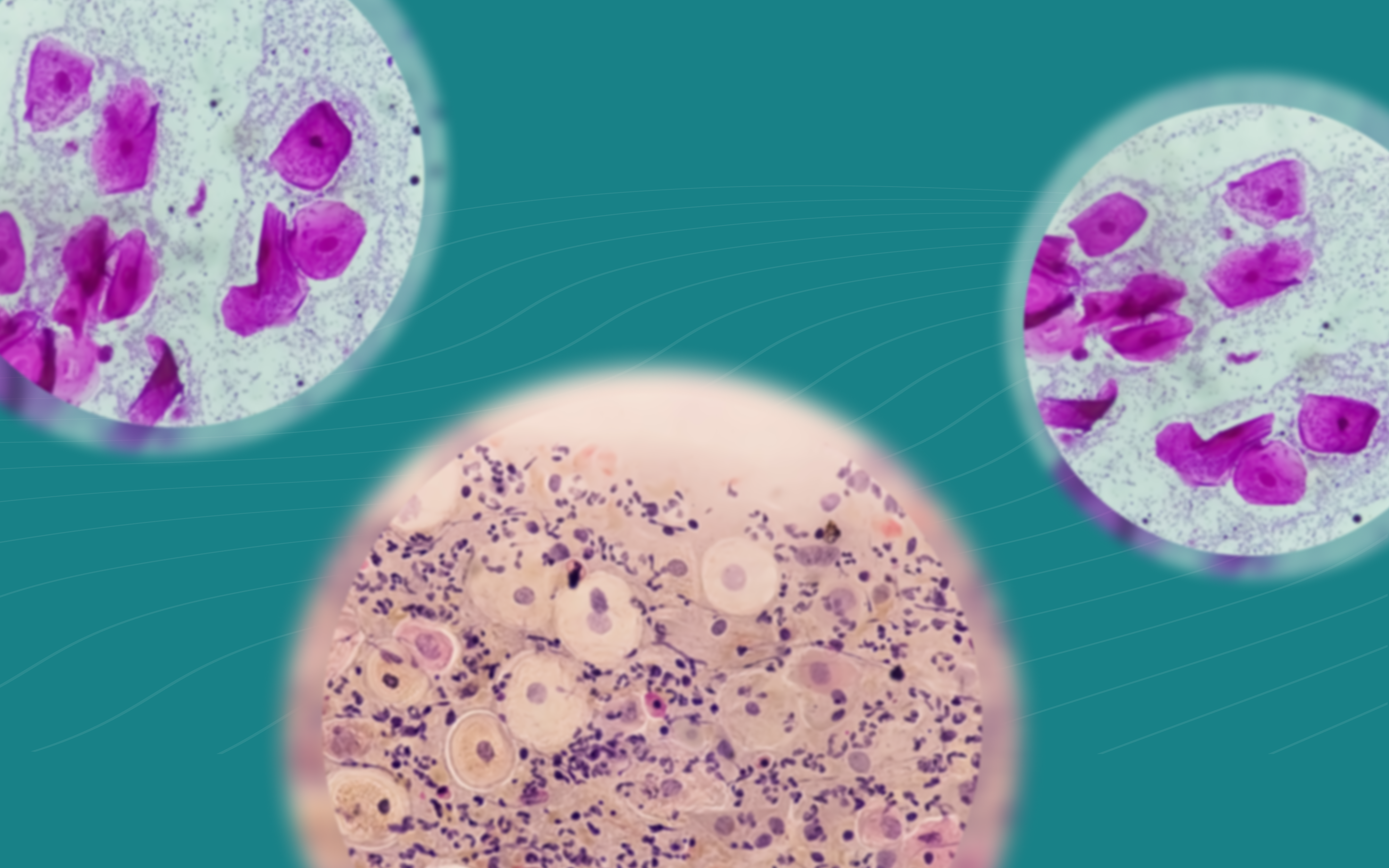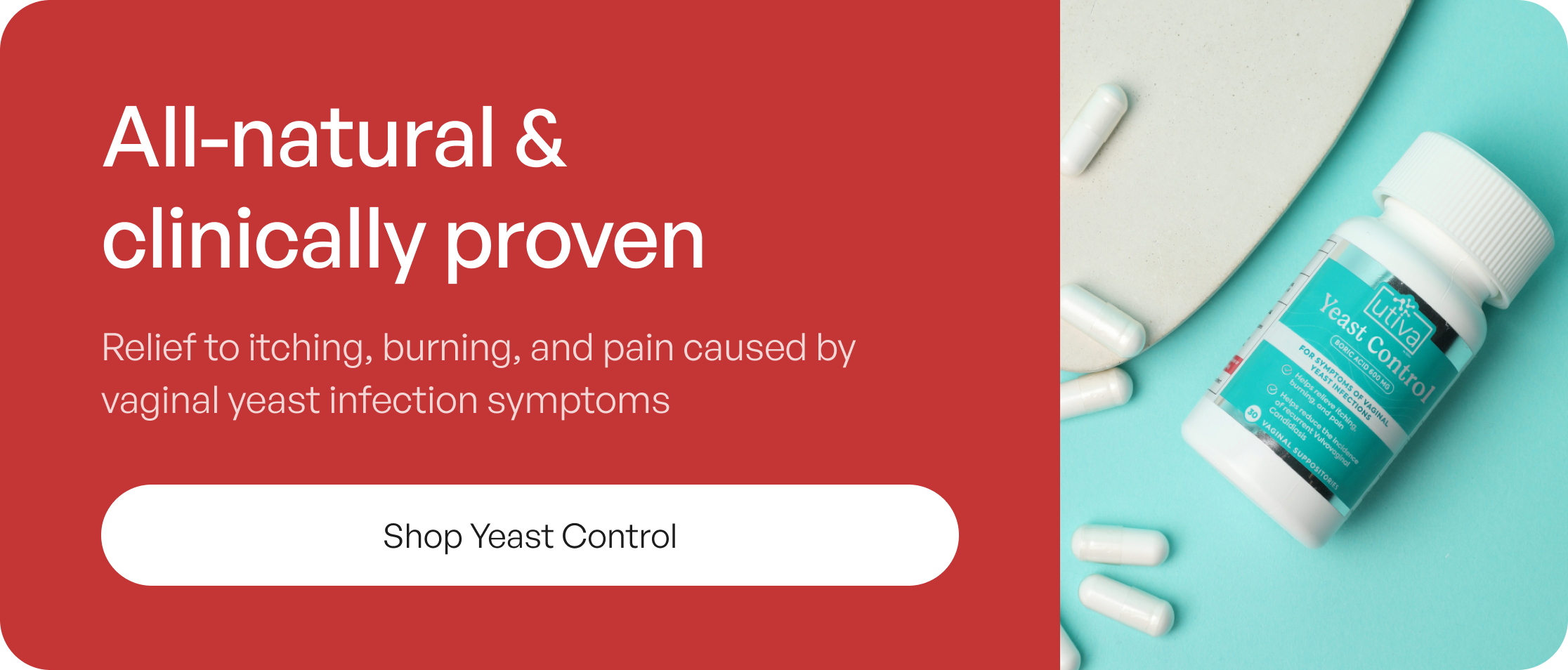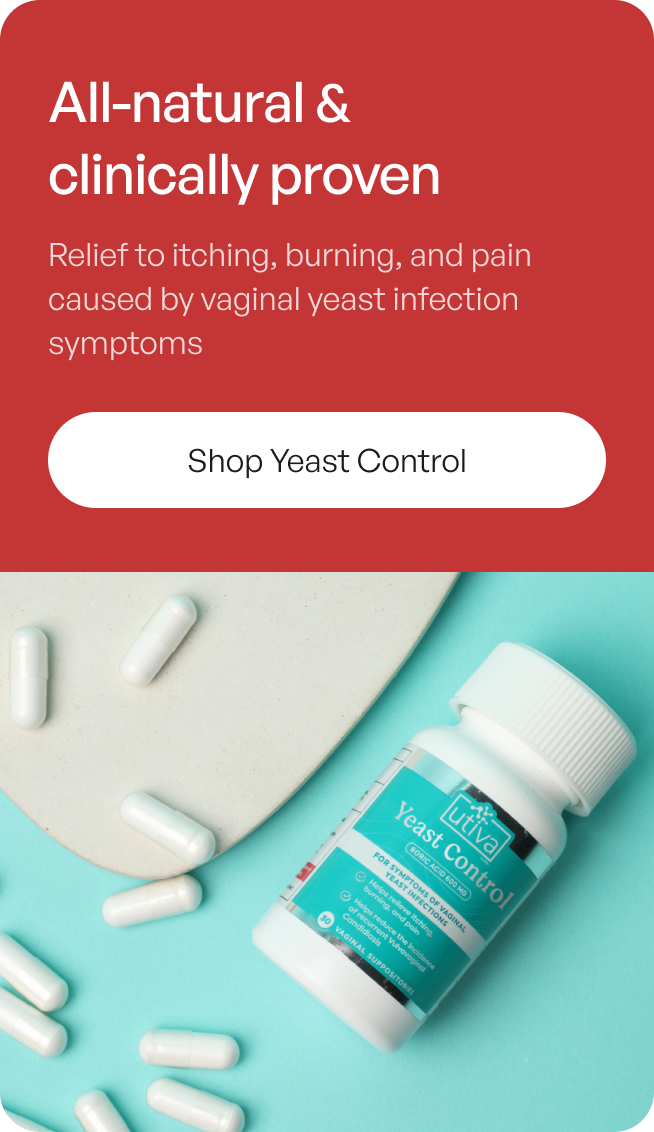Yeast Infections vs. Bacterial Vaginosis: The Differences, Similarities, and Natural Solutions

Vaginal infections are shockingly normal. 75% of women will get a yeast infection in their lifetime, and 30% will experience bacterial vaginosis.
Both conditions are caused by an imbalance of bacteria in the vagina. They even share similar symptoms. But there are key differences that impact how you treat and prevent each infection.
Let’s explore the signs, causes, and treatment options for yeast infections and bacterial vaginosis. Plus the best natural solutions—from boric acid to lactic acid—to keep future infections far away from your vagina.
What is a yeast infection and how does it happen?
Your vagina naturally contains a mix of bacteria and yeast. Good bacteria, like Lactobacilli, work to keep the environment balanced and stop harmful bacteria from taking over.
But when that balance gets interrupted, bacteria can overgrow and cause infection. A yeast infection happens when a type of yeast called Candida takes over and outnumbers the healthy cells.
There are several reasons why this happens. Some potential causes of yeast infection include:
- Using antibiotics incorrectly or too often
- Sex
- Birth control pills that are high in estrogen
- Pregnancy
- Weak immune system
- Wearing tight-fitting clothes or sitting in wet clothes for too long
- Irritants like soaps or douches
- Having diabetes
What is bacterial vaginosis?
Bacterial vaginosis—also known as BV—is similar to a yeast infection in a lot of ways. It happens when the normal balance of bacteria in the vagina gets disrupted, usually caused by a decrease in the amount of Lactobacilli.
There is one crucial difference though. While a yeast infection is caused by a Candida overgrowth, BV occurs when a type of bacteria called an anaerobe takes over. These anaerobic bacteria are super sensitive to changes in the vaginal pH. When it rises, they multiply.
This bacterial imbalance might happen for a number of reasons, including:
- Frequent bathing or douching
- Having multiple sex partners or more sex than usual
- High stress levels
- Smoking
- Menstruation
How do you know whether you have a yeast infection or BV?
It’s no wonder these two infections get confused for each other. Their symptoms can feel frustratingly similar. But understanding the differences can help you know which infection you might have.
Common symptoms of yeast infection include thick, odourless discharge with a cottage cheese consistency, vaginal soreness, itching, and other irritations like redness, swelling, and burning.
BV shares some of these symptoms, including increased discharge, itching, and irritation. However, BV will look (and smell) slightly different. The discharge caused by BV is typically thinner, with a distinctive fishy odour and a yellow, green, or gray colour.
When in doubt, always talk to your doctor about your symptoms. They can run tests and give you a proper diagnosis, a more effective treatment, and a game plan for stopping the infection from coming back.

How do you treat yeast infections and BV?
Yeast infections are usually treated by antifungal creams or suppositories in the azoles family. Your doctor might also prescribe oral medication to soothe inflammation and other symptoms.
For BV, your doctor might prescribe antibiotics to kill the harmful bacteria causing the infection. This could be in pill or topical gel form.
Pro tip: Always take antibiotics exactly as prescribed by your doctor to avoid antibiotic resistance. If you stop your treatment too early—or take the antibiotics incorrectly—the bacteria in your body can grow resistent and stop responding to future treatments.
Can you use boric acid for yeast infections?
To avoid harsh medical treatments, many people turn to natural solutions like boric acid. A scientific review of 14 studies found that boric acid is an effective, safe, and affordable alternative for treating recurrent yeast infections.
How exactly does it work? When boric acid enters the vagina, it makes the entire area more acidic. This balances the flora—AKA the hundreds of bacteria and microorganisms living in your vagina.
Boric acid also attacks fungi by disrupting oxidative metabolism in its cells. In other words, making it impossible for fungi to survive and grow. Yep—Candida included. Boric acid is even better at attacking fungi than traditional antifungal medications.
Utiva’s Yeast Control is a boric acid suppository that is clinically proven to target and treat yeast infections at the source. It works fast, so you can feel relieved of symptoms sooner. Best of all, it holistically prevents future infections and promotes good vaginal health overall.
What is the best natural BV treatment?
Many people assume that you can also use boric acid for BV. But there are two ingredients that can more effectively target BV symptoms and restore your vagina’s natural pH.
1. Lactic acid. This molecule is naturally produced in your body to help your cells, tissues, and organs function. It can also relieve common symptoms of BV, like vaginal discharge and fishy odours, and bring your vagina’s pH back into balance.
2. Hyaluronic acid. You’ve probably seen this ingredient in your skincare. It’s incredible at hydrating the skin and soothing inflammation. And if you have BV, it can be a life-saver for relieving soreness, irritation, and itching around the vagina.
Utiva’s Bacterial Vaginosis Relief is formulated with both lactic acid and hyaluronic acid to soothe BV symptoms. It also maintains a balanced vaginal ecosystem, so BV is less likely to make a comeback.
This is especially helpful for women who tend to get BV around their periods. Taking Bacterial Vaginosis Relief for 2-3 days after menstruating reduces the risk of BV recurrence.
You deserve a happy, healthy vagina.
Yeast infections and BV may be common, but they shouldn’t be. With the right education, treatment, and preventative supplements, you can free yourself from the burden of vaginal infections. Talk to your doctor about your vaginal health and how natural solutions, like Utiva, might help.
Eager to learn more about your vagina? (We totally get it—it’s fascinating). Hit up the Utiva blog for research and insights on UTIs, vaginal health, gut health, and more.
References:
- https://www.yalemedicine.org/conditions/yeast-infection
- https://vpfw.com/blog/bv-vs-yeast-infection-understanding-the-differences-and-similarities
- https://pubmed.ncbi.nlm.nih.gov/21774671/
- https://www.health.harvard.edu/a_to_z/vaginal-yeast-infection-a-to-z
- https://pubmed.ncbi.nlm.nih.gov/30624309/
- https://www.medicalnewstoday.com/articles/326521
- https://www.medicalnewstoday.com/articles/326385#is-it-effective
- Kennedy M.A., Sobel J.D. Vulvovaginal candidiasis caused by non-albicans Candida Species: New insights. Curr. Infect. Dis. Rep. 2010;12:465–470. doi: 10.1007/s11908-010-0137-9. [PubMed] [CrossRef] [Google Scholar]
- Parazzini F., Di Cintio E., Chiantera V., Guaschino S. Determinants of different Candida species infections of the genital tract in women. Sporachrom Study Geoup. Eur. J. Obstet. Gynecol. Reprod. Biol. 2000;93:141–145. doi: 10.1016/S0301-2115(00)00289-X. [PubMed] [CrossRef] [Google Scholar]
- Richter S.S., Galask R.P., Messer S.A., Hollis R.J., Diekema D.J., Pfaller M.A. Antifungal susceptibilities of Candida species causing vulvovaginitis and epidemiology of recurrent cases. J. Clin. Microbiol. 2005;43:2155–2162. doi: 10.1128/JCM.43.5.2155-2162.2005. [PMC free article] [PubMed] [CrossRef] [Google Scholar]
Knowledge is power
Sign up to our newsletter to keep learning!

- Choosing a selection results in a full page refresh.
- Opens in a new window.






